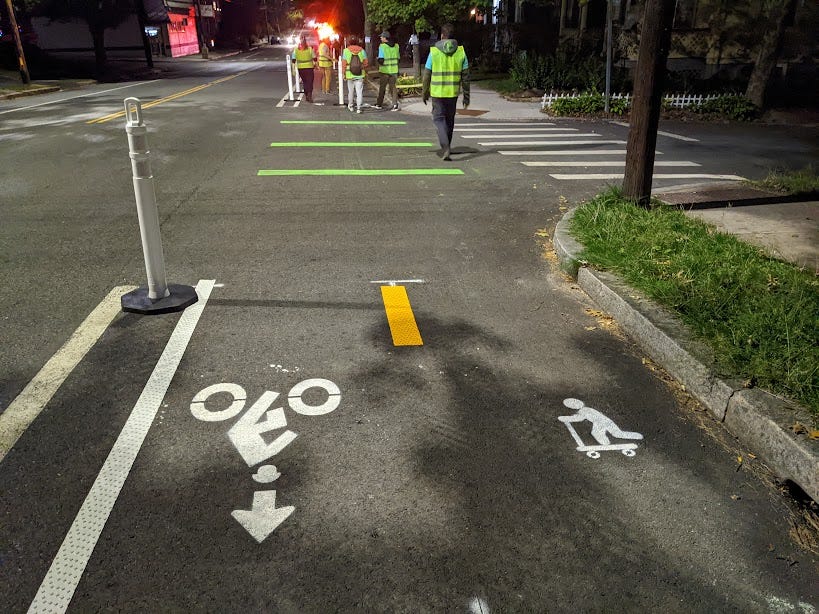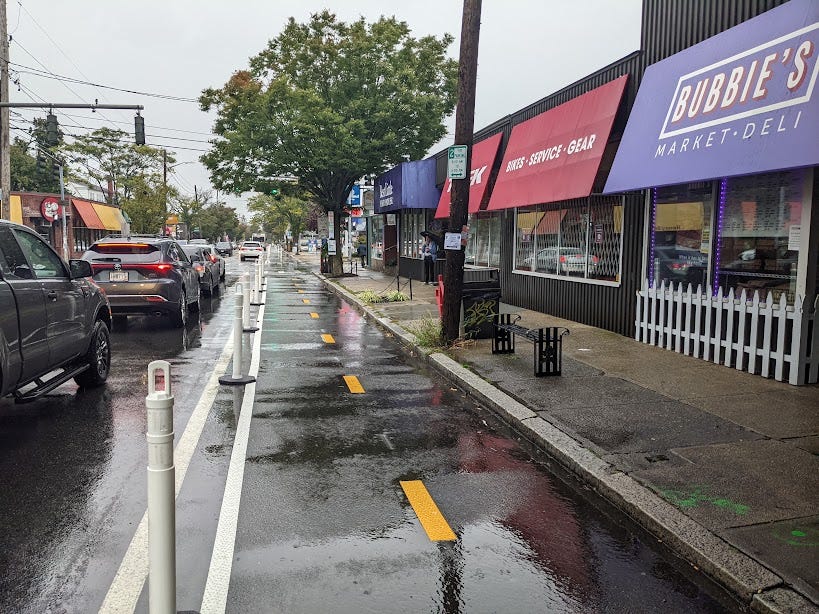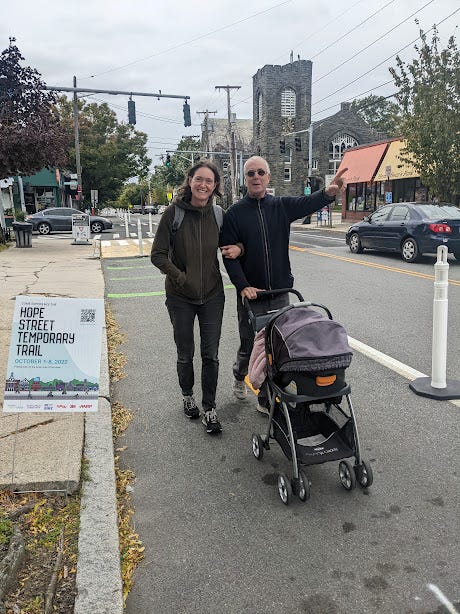In the media biz, we use the term “evergreen” to describe articles that will have a long shelf life for readers when it comes to usefulness. That’s pretty much the way MIND THE MOSS works too. I want you to scroll through the archives, squirrel away ideas for future hikes, etc. But today, I want to draw your attention to a very cool urban hiking opportunity that will only last through this Saturday. It speaks to a new concept of hiking trails that might be coming to a city near you in the years ahead…
If you’ve spent any time on Hope Street in Providence—say, procuring flaky croissants at Seven Stars Bakery, or splurging for the tasting menu at Persimmon—then you know it’s one of the city’s busier streets. As a denizen of the sidewalk, you might feel intimidated and outmatched by the cacophony of traffic here. This is grimly common in every U.S. city. Streets that serve as arteries for commerce and recreation are built to accommodate cars first and foremost, with spaces for pedestrians, cyclists, and people using mobility devices all playing second fiddle to the vehicular traffic lanes.
But thanks to the tremendous advocacy and labor of Providence Streets Coalition, Thriving Places Collaborative, Rhode Island Bicycle Coalition, SPIN Streets, AARP, and 3M Gives, a one-mile stretch of Hope Street has been transformed into a “temporary trail” that extends from Lauriston Street to Olney Street. A sizable portion of the street has been demarcated as a protected two-way path that people can utilize by “walking, jogging, rolling, and biking.” The Hope Street Temporary Trail is a 3-D case study in what city streets could look like if more spaces were devoted to non-vehicular users, and the groups that made this trail possible are actively encouraging people to visit Hope Street, test the trail, and send feedback about their experience by the evening of 10/9, when the trail will be disassembled and the street returned to the cars. For now.
Now I know some of us aren’t yet convinced that a street walk in an urbanized area can be considered a “hike.” But what is hiking if not walking through a scenically rich range of environments? In theory, you could take a multi-use path like the Hope Street Temporary Trail to reach multiple public green spaces like Lippitt Memorial Park, or Summit Avenue Playground. One person who seems to recognize this is Providence’s outgoing Mayor Jorge Elorza, who has made establishing urban trails across the city streets a priority during his time in office. Mayor Elorza’s potential successors have all promised the public that they’ll continue to support this project, which speaks to its general reception among PVD residents. But the city does not yet have the funding allocated for establishing new permanent trails in places like Hope Street. Your beta-testing of the temporary trail and your feedback will be appraised by the city, which makes this a rare opportunity to potentially help catalyze a new multi-use urban trail.
But there’s another reason to go and hike the Hope Street Temporary Trail before this Saturday night, and it speaks to the question that some of you may be thinking. Why not just use the sidewalk that already exists? This is where the symbolic weight of a temporary trail comes into play. Projects like these are a tremendous uphill battle, given the historic political power of car owners and manufacturers. We are finally reckoning with the outcomes of designing cities for cars—air pollution, truncated mobility options for pedestrians and cyclists, and an increase in deadly car collisions. Even temporarily designating a portion of one street for people without vehicles is an act of assertively reclaiming space, and this is something that will have to be done more often if we want to expand the range of public places where hiking can happen.
The common refrain against a project like the Hope Street Temporary Trail is that it will exacerbate traffic by reducing parking capacity. But studies on parking space occupancy on Hope Street found that on average, over 70% of the parking spots on the street remained empty! This was a crucial discovery that helped designate Hope Street as a place where the concept of re-purposing streets as trails could be tested. There will always be major streets that are ill-suited for lane reduction in urban areas, but that’s no reason to dismiss the possibility of applying the concept to other parts of the city. And that’s what the Hope Street project is: a visionary, targeted application.
The question of how much space cars should be allowed to take up on city streets in the future is a daunting one: particularly in the face of worsening climate change and growing evidence that “walkability” is physiologically and economically beneficial for cities. Some municipalities in Europe are moving toward banning cars outright from their downtown centers. Personally, I would love to see that idea realized in the U.S. (and I say that as a reluctant car owner.) But at a time when something as hyper-local and hard-won as the Hope Street Temporary Trail is basically a breakthrough, it’s safe to say that we’ve got very steep, hulking mountain ahead of us to climb. That’s why I encourage any of you who can make it to Providence by this Saturday to check out Hope Street’s fleeting trail. It could be a literal first step toward something bigger.
CLICK HERE to learn more about the Hope Street Temporary Trail, how to hike it, and how to submit your feedback after your visit. Oh, and by the way, in case any of you happen to be in the city or heading there tomorrow (Thursday 10/6) the Providence Streets Coalition will be hosting a free outdoor screening of THE STREET PROJECT, a documentary on the growing global movement to reclaim streets for a wider spectrum of users. CLICK HERE to register and let me know how the movie was!
In case any of you happen to pick up the October issue of Boston Magazine soon, I’ve got a big travel feature in there about the White Mountains. It’s a notch-by-notch guide to four distinct regions within the sprawling mountain range, including the remote and mysterious Evans Notch. The feature spotlights a handful of classic White Mountain destinations like Zealand Falls and Tuckerman Ravine, but it also includes several deeper cuts like the Bartlett Experimental Forest, which I’ve already been chewed out for “ruining” by an angry email reader who wasn’t too happy to see the place spotlit for the unwashed and unworthy hordes. (It’s a U.S. Forest Service site, so IDK man.)
Speaking of White Mountains, there was a pretty bonkers search-and-rescue mission up there recently. Two guys basically went freestyle rock climbing with zero gear and in doing so, they put rescuers in an extremely dicey position. The state has decided to criminally punish them with fines. On the one hand, I think that makes sense in this instance. But it also points to a broader trend we’re seeing across several states that I find troubling—billing hikers for the cost of search and rescues that are deemed to have resulted from negligence on the part of the hiker. The problem, as I see it, is that negligence is subjective. It could be bushwhacking into a ravine, or forgetting to throw a fleece in your bag and getting hypothermia during a surprise shower. Even the most experienced hikers act carelessly now and then. The threat of 4-5 figure bill for being rescues is not likely to deter people from hiking but it could deter people from calling for help in the early stage of an emergency, when a rescue might be easier to pull off.
Anyway, I’ll spare you the rest of my sermon and leave you with the Globe article.








Creating narrower streets actually slows traffic and reduces traffic. Good for everyone including motor vehicles users. Induced demand is a proven result of wider streets especially now with map apps. I support any infrastructure that takes space back from cars. Great project
What this looks like to me is putting in a bike path and then making it completely unusable by encouraging people to walk/wheelchair on it. Then the public feedback will be the walkers and wheelchair users complaining about the bikers going too fast, and the bikers using the street anyway because of the speed differential. This seems like a very odd idea.